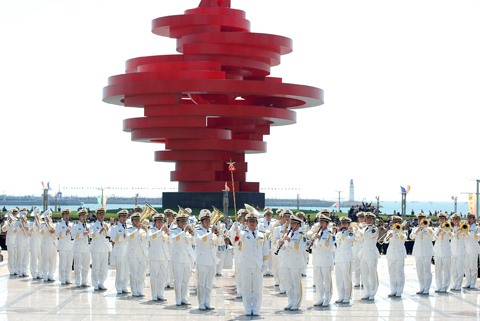The Chinese navy has added sophisticated nuclear submarines, destroyers and missile systems, but the holy grail of surface ships — an aircraft carrier — has stayed out on the horizon.
That may be about to change.
The navy will have one “very soon,” said the commander of the East China Fleet, Admiral Xu Hongmeng. The navy’s commander, Admiral Wu Shengli (吳勝利), spoke last week of plans for “large combat warships,” an apparent reference to carriers.

PHOTO: EPA
The comments come ahead of an unprecedented international fleet review tomorrow marking the 60th anniversary of the People’s Liberation Army (PLA) Navy and spotlighting its recent rapid development.
The navy is expected to take on even more ambitious goals in the next few years as it seeks to strengthen its ability to operate far from coastal bases and boost China’s international prestige.
“As China’s navy takes on missions that go beyond simple coastal defense, an aircraft carrier becomes an obvious addition to maritime power projection platforms,” said John Pike, a defense analyst and director of GlobalSecurity.org.
In his remarks to Xinhua news agency, Wu said the navy would speed up development of a technologically advanced, oceangoing fleet, stepping away from its traditional missions of coastal protection and blocking permanent independence for Taiwan.
No Chinese official has offered a specific timeframe for putting a carrier in the water or said how many might be built.
Operating a carrier would be a step toward a “sea-control capability” in Northeast Asia and the Indian Ocean, a strategy that could bring Beijing into conflict with the US, Japan, South Korea and India and raise doubts about Beijing’s self-declared defensive military posture, Pike said.
“It is not clear how such a long-range power projection and sea control strategy would fit in with China’s peaceful rise,” he said.
Having a carrier allows a navy to operate fixed-wing aircraft beyond the range of aircraft based on land. That would be key on missions to defend China’s territorial aspirations, especially in the South China Sea, where a half-dozen countries have overlapping claims.
US officials say they don’t think a Chinese carrier would pose much of a threat to their operations in the region, although that would depend on how China intended to use it.
In China to attend this week’s festivities, Admiral Gary Roughead, chief of US naval operations, said on Sunday there is “no doubt in my mind” that Beijing wants a carrier, but he said US forces would take such a development in stride.
“The advent of an aircraft carrier on the part of the PLA Navy, to me, really doesn’t change the nature of our operations at all,” Roughead said.
China insists it has both the financial muscle and shipbuilding ability to construct and operate a carrier and the development of sophisticated new home-built vessels seems to support that view.
Such expansion has been made possible by two decades of near-annual double-digit increases in military spending. China has announced a 14.9 percent rise in military spending in its budget for this year, to 480.6 billion yuan (US$70.3 billion).
The 225,000-sailor PLA Navy already operates more submarines than any other Asian country, with up to 10 nuclear-powered vessels and as many as 60 diesel-electric subs. It boasts almost 80 destroyers and frigates — more than a dozen of which have entered service since the 1990s — along with hundreds of smaller craft and support ships.
China’s second-generation, nuclear-powered Jin and Shang class submarines are considered just a notch below cutting-edge US and Russian craft.
The diesel-electric Yuan class boasts a Chinese-developed air-independent propulsion system that allows it to remain submerged for weeks, while Chinese Luyang destroyers and Jiangkai missile frigates incorporate stealth features and a mix of latest-generation Chinese and Russian weapon systems.
Still, operating an aircraft carrier requires orchestrating a highly complex matrix of sailors, aircraft, missile defenses, power plants, support ships, fuel and weather. In that, the Chinese navy has little experience.
“Carrier operations are very complex, difficult, and dangerous,” said retired Rear Admiral Eric McVadon, a former US Navy pilot who is now director of Asia-Pacific Studies at the Institute for Foreign Policy Analysis. “China’s current navy is not designed for carrier warfare.”
McVadon said China would build up to three modest carriers considerably smaller than the US Navy’s 100,000-tonne displacement Nimitz class carriers.
Unconfirmed reports have emerged on the Internet pointing to the construction of a dedicated carrier-building dock outside Shanghai.

TURNAROUND: The Liberal Party had trailed the Conservatives by a wide margin, but that was before Trump threatened to make Canada the US’ 51st state Canada’s ruling Liberals, who a few weeks ago looked certain to lose an election this year, are mounting a major comeback amid the threat of US tariffs and are tied with their rival Conservatives, according to three new polls. An Ipsos survey released late on Tuesday showed that the left-leaning Liberals have 38 percent public support and the official opposition center-right Conservatives have 36 percent. The Liberals have overturned a 26-point deficit in six weeks, and run advertisements comparing the Conservative leader to Trump. The Conservative strategy had long been to attack unpopular Canadian Prime Minister Justin Trudeau, but last month he

OPTIMISTIC: A Philippine Air Force spokeswoman said the military believed the crew were safe and were hopeful that they and the jet would be recovered A Philippine Air Force FA-50 jet and its two-person crew are missing after flying in support of ground forces fighting communist rebels in the southern Mindanao region, a military official said yesterday. Philippine Air Force spokeswoman Colonel Consuelo Castillo said the jet was flying “over land” on the way to its target area when it went missing during a “tactical night operation in support of our ground troops.” While she declined to provide mission specifics, Philippine Army spokesman Colonel Louie Dema-ala confirmed that the missing FA-50 was part of a squadron sent “to provide air support” to troops fighting communist rebels in

PROBE: Last week, Romanian prosecutors launched a criminal investigation against presidential candidate Calin Georgescu accusing him of supporting fascist groups Tens of thousands of protesters gathered in Romania’s capital on Saturday in the latest anti-government demonstration by far-right groups after a top court canceled a presidential election in the EU country last year. Protesters converged in front of the government building in Bucharest, waving Romania’s tricolor flags and chanting slogans such as “down with the government” and “thieves.” Many expressed support for Calin Georgescu, who emerged as the frontrunner in December’s canceled election, and demanded they be resumed from the second round. George Simion, the leader of the far-right Alliance for the Unity of Romanians (AUR), which organized the protest,

ECONOMIC DISTORTION? The US commerce secretary’s remarks echoed Elon Musk’s arguments that spending by the government does not create value for the economy US Secretary of Commerce Howard Lutnick on Sunday said that government spending could be separated from GDP reports, in response to questions about whether the spending cuts pushed by Elon Musk’s Department of Government Efficiency could possibly cause an economic downturn. “You know that governments historically have messed with GDP,” Lutnick said on Fox News Channel’s Sunday Morning Futures. “They count government spending as part of GDP. So I’m going to separate those two and make it transparent.” Doing so could potentially complicate or distort a fundamental measure of the US economy’s health. Government spending is traditionally included in the GDP because